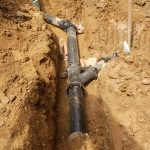Waste to Hydrogen: Circular Economy

What is GPR?
Ground penetrating radar, also known as GPR, is a method of mapping the subsurface of the ground. It is a non-destructive imaging method that uses electromagnetic radiation and detects the reflections from subsurface structures. It is used in a variety of industries and fields, including archaeology, underground exploration and structure inspection. In the right material, GPR can map the underground structure for thousands of meters. In Greenland, the ice-sheets have been mapped as deep as the bedrock in some places.
Why use GPR for pavement investigation?
There are cases where someone wants to get knowledge of the subsoil structures without destroying the surface or digging holes. A good example of when this is useful is in road inspections. Many roads throughout the world are very old. Some highways in the USA can be dated back to the 1930’s and there comes a time when these roads need to be upgraded.
If you are the expert in charge of upgrading the road, then you need to conduct a full analysis and develop a plan of action. The first thing to decide is whether to keep the original road base, or whether to strip it away and start again. GPR can help make this decision, as it provides detailed data about the pavement thickness, localised anomalies and defects or weaknesses.
The traditional method of pavement investigation includes a number of destructive processes, but still doesn’t provide as much information as a good quality GPR scan. The traditional method includes things like asphalt coring (which leaves holes in the pavement), soil investigations and Falling Weight Deflectometer surveys. These all take a lot of time and effort to conduct and should be replaced or at the minimum used in conjunction with GPR.
The benefits of using GPR for pavement investigation
There are a huge number of benefits to using GPR over using traditional pavement investigation services. These include:
- The price: GPR is much less labour intensive than traditional inspections and therefore cheaper.
- It is nondestructive: While traditional methods involved sampling the pavement at certain intervals to ensure that the foundations and structure are sound, GPR is completely nondestructive.
- It is accurate: As long as you have an experienced operator who knows how to use the machine, GPR is one of the most accurate forms of imaging on earth.
For more information contact your local GPR expert today!
Related Posts

Subsurface Utility Engineering (SUE): Reducing Risk and Improving Projects
Construction and infrastructure projects across Australia face numerous challenges, from managing budgets and timelines to ensuring safety and minimising disruptions.
Read more
PUP Underground Locating: Essential for Safe Excavation
Excavation is a necessary activity which ranges from large infrastructure projects to smaller residential works.
Read more
Non-Destructive Digging: The Safe and Efficient Way to Excavate
Traditional excavation methods, involving heavy machinery and extensive digging, often pose significant risks to underground utilities, the environment, and worker safety.
Read moreTalk with us today to find out more
Please call and speak with one of our friendly members of staff or send us an email using our contact form